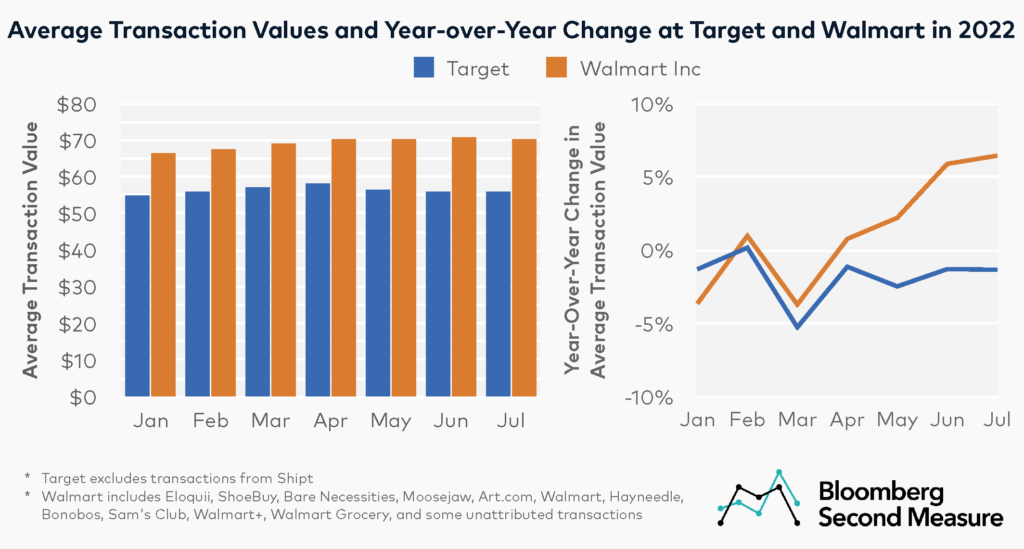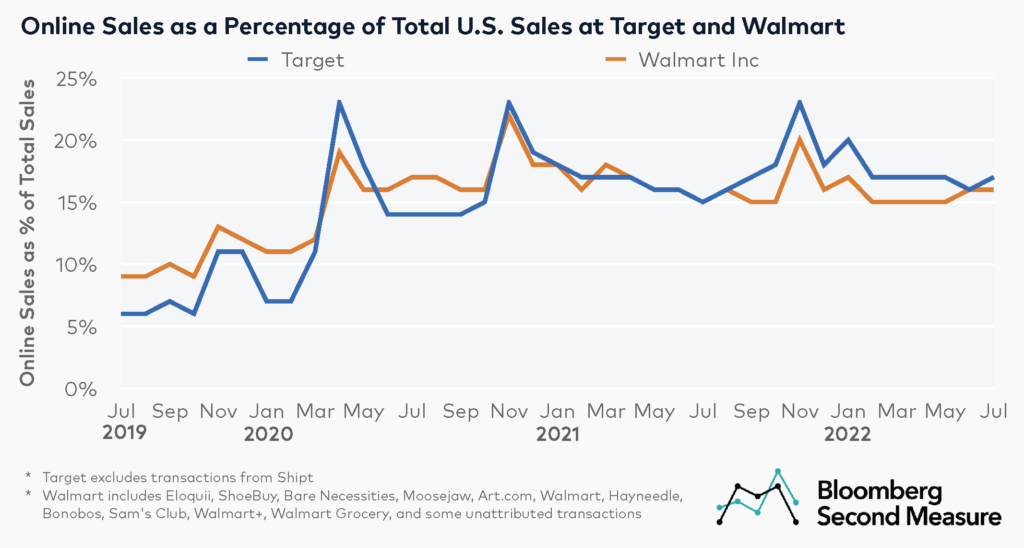Big-box stores Target Corporation (NYSE: TGT) and Walmart Inc (NYSE: WMT)—which both recently reported their quarterly earnings—have faced excess inventory challenges over the last few months, slashing prices even as inflation has soared to new heights. Our credit and debit card transaction data reveals that in 2022, monthly average transaction values have generally increased year-over-year at Walmart Inc, but decreased slightly at Target. Additionally, our analysis shows that the share of online sales at both retailers is still elevated compared to pre-pandemic levels.
Average transaction values rose at Walmart Inc (NYSE: WMT), but dipped slightly at Target (NYSE: TGT) in 2022
Consumer transaction data shows that for five out of seven months from January through July of 2022, Walmart Inc’s monthly average transaction value exceeded the same month a year prior. Conversely, Target’s monthly average transaction value has been lower than the previous year for six out of the last seven months. In July 2022, the average transaction value at Walmart Inc was $70, a 6 percent increase from the previous year. At Target, the average transaction value in the same month was $56, a 1 percent decrease year-over-year.

At both Target and Walmart Inc, the average transaction value in July 2022 was about the same as the previous month. Walmart’s monthly average transaction values have increased slightly or remained consistent month-over-month for every month so far in 2022. Average transaction values at Target increased slightly month-over-month from January through April, then decreased slightly or remained consistent from May through July. Target includes sales from Target stores and Target.com, but excludes sales from Shipt. Walmart Inc includes Eloquii, ShoeBuy, Bare Necessities, Moosejaw, Art.com, Walmart, Hayneedle, Bonobos, Sam’s Club, Walmart+, Walmart Grocery, and some unattributed transactions.
Credit and debit card transaction data shows that the share of online sales at Walmart and Target has increased during the COVID-19 era
While most sales for both big-box retailers continue to originate from the retail channel, the share of online sales as a percentage of total sales increased during the early months of the pandemic and has largely remained elevated into 2022.

In July 2022, 17 percent of sales at Target and 16 percent at Walmart Inc came from ecommerce purchases. During the same month in 2019, only 6 percent of Target’s sales and 9 percent of Walmart Inc’s sales were from the online channel. The share of online sales at both companies surged in April 2020—to 23 percent for Target and 19 percent for Walmart Inc—when shelter-in-place orders first went into effect.
Both companies also experienced an uptick in the percentage of online sales during November of each year. Most recently, in November 2021, 23 percent of Target’s sales and 20 percent of Walmart Inc’s sales were from online spending. A likely factor is that Target and Walmart closed their brick-and-mortar locations on Thanksgiving in 2020 and 2021, and Cyber Monday took place in November, so more sales may have shifted online during that period.
In a bid to compete with Amazon Prime, Walmart also recently announced that Walmart+ members will also receive free access to the streaming service Paramount+.
Big-box stores seeing consumer interest in groceries and back-to-school shopping
Between the two retailers, a higher percentage of sales at Walmart reportedly comes from groceries, compared to Target. Walmart has reportedly seen shoppers shift more of their spending toward groceries—including private-label brands—rather than higher-priced merchandise like apparel, electronics and home goods. Walmart is also reportedly experiencing an increase in higher-income customers seeking inexpensive groceries as inflation squeezes consumer spending. Grocery chains have also seen year-over-year increases in sales and average transaction value amid inflation.
Retailers like Walmart and Target, as well as Bed, Bath and Beyond, are also major destinations for back-to-school shopping. Target’s CEO has publicly stated that the back-to-school shopping season is off to an “encouraging start.”
Bloomberg Second Measure launched a new and exclusive transaction dataset in July 2022. Our data continues to be broadly representative of U.S. consumers. As a result of this panel change, however, we recommend using only the latest post in assessing metrics, and do not support referring to historical blog posts to infer period-over-period comparisons.
